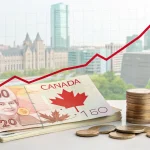The U.S. stock market plunged on Thursday following the White House’s clarification of a massive 145% tariff on China, escalating an ongoing trade war. The Dow Jones fell 1,015 points, or 2.5%, after a volatile day, pulling back from a mid-day low of a 2,100-point drop. The S&P 500 and Nasdaq Composite also slid 3.46% and 4.31% respectively, as investors grappled with the implications of the tariff increases.
Traders on the New York Stock Exchange reacted negatively to President Donald Trump’s about-face regarding tariff levels. Although Trump temporarily paused some of his “reciprocal” tariffs, the damage from other substantial tariffs had already impacted the market. Economists indicate that the ramifications of these tariffs are likely irreversible.
In a statement, Trump acknowledged the potential for “transition problems” following the tariff clarifications but remained optimistic about the state of the U.S. economy. “We’re very, very happy with the way the country is running. We’re trying to get the world to treat us fairly,” Trump said during a meeting in the Cabinet Room.
The U.S. dollar index fell 1.7% on Thursday, reaching its lowest level since early October, reflecting investor concerns about the nation’s economic health. Simultaneously, gold prices reached a record high above $3,170 per troy ounce, marking its best quarter since 1986 as investors sought safe-haven assets amid economic uncertainty. Trump’s temporary rescission of some tariffs had initially buoyed traders, with hopes that the European Union’s announcement of negotiations could mitigate some trade tensions.
Treasury Secretary Steven Mnuchin mentioned that more than 70 countries were aligned to negotiate trade deals with the U.S., emphasizing a desire to strike new deals within the 90-day respite. Despite this temporary relief, many economists believe the economic discord remains profound. Recession risks persist, with Goldman Sachs and JPMorgan maintaining that the probability of a U.S. and global recession remains high despite Trump’s recent policy reversals.
The CBOE Volatility Index, often referred to as Wall Street’s fear gauge, surged 40% on Thursday, an indication of extreme market volatility. April data also indicated a sharp slowdown in inflation, yet market focus remains firmly on tariff implications and future economic outlooks. Compounding concerns, Beijing implemented retaliatory 84% tariffs on U.S. imports, signaling its unwillingness to back down from the trade conflict.
A Chinese Commerce Ministry spokesperson reiterated the nation’s stance for mutual respect and equality in negotiations, warning against further U.S. escalations. Investor stress extended beyond the stock market. The bond market saw the 10-year Treasury yield rise above 4.3%, indicating continued concern.
Additionally, oil prices remained under pressure, with U.S. oil falling below $60 a barrel. Global markets, however, showed some resilience. Japan’s Nikkei 225 index closed more than 9% higher, South Korea’s Kospi index rose 6.6%, and Hong Kong’s Hang Seng index jumped 2.1%.
The evolving trade war and its economic impacts continue to stir uncertainty and volatility across markets worldwide. The Dow Jones Industrial Average fell for a third consecutive day following President Donald Trump’s recent tariffs announcement against China on Monday. This session marked unprecedented volatility, with the Dow experiencing its largest intraday point swing ever recorded.
Trading volume reached its highest level in at least 18 years, with about 29 billion shares traded, surpassing Friday’s volume of 26.77 billion shares and the 10-day average of 16.94 billion shares. The Dow dropped 349.26 points, or 0.91%, to close at 37,965.60. During its Monday session low, the 30-stock average had fallen more than 1,700 points, then swung 2,595 points from low to high in a record reversal.
The S&P 500 shed 0.23% to end at 5,062.25, briefly entering bear market territory during the session, but was off nearly 18% from its recent high. The Nasdaq Composite inched higher by 0.10% to settle at 15,603.26, with investors buying megacap tech stocks like Nvidia and Palantir. At its session low, the tech-heavy index was off more than 5%.
Stocks saw a brief rally, pushing the Dow Industrials into positive territory due to speculation of a tariff pause circulated on social media. However, the White House quashed these rumors, calling the talk of a 90-day pause “fake news,” leading to a retreat in major averages. Despite the sell-off, the White House confirmed that the tariffs announced on Wednesday evening would take effect on April 9, as scheduled.
stock market’s turbulent response
China retaliated on Friday, with other countries readying their own counter-tariffs. On Monday, Trump threatened Beijing via Truth Social, stating, “If China does not withdraw its 34% increase …
the United States will impose additional tariffs on China of 50%, effective April 9.” Trump also confirmed no pause in the tariff plan. Market fears were compounded by potential margin calls, with the VIX, Wall Street’s fear gauge, surging to the 60 level, an extreme threshold seen mostly during bear markets. “Margin calls are going out as we speak,” said Chris Rupkey, chief economist at FWDBONDS.
U.S. crude oil prices fell about 2% on Monday, adding to last week’s steep losses on concerns that the tariffs could push the U.S., and possibly the world, into a recession. U.S. crude oil fell $1.29, or 2.08%, to close at $60.70 per barrel, while Brent lost $1.37, or 2.09%, to settle at $64.21. The 10-year Treasury yield rallied above 4.15%, erasing most of its declines from Thursday and Friday.
“I think this bounce today is somewhat reaffirming in that markets aren’t anticipating a free fall,” said Mona Mahajan, head of investment strategy at Edward Jones. If Trump’s tariffs push the U.S. economy into a recession, chip stocks could fall at least another 20%, according to Citi. “We believe the biggest risk to the semi sector is a recession resulting from tariffs,” wrote Chris Danely, managing director at Citi.
Despite the risk of a sharp downturn, Danely anticipates a “sharp rebound” once supply chains and tariff impacts stabilize. CEO’s are increasingly pessimistic about the U.S. economy, even before the tariffs announced by Trump last week take full effect, according to BlackRock CEO Larry Fink. “Most CEOs I talk to would say we are probably in a recession right now,” Fink said at an event for the Economic Club of New York.
This tumultuous trading session has investors on edge as global economic stability remains uncertain. Stock markets have been thrown into chaos after U.S. President Donald Trump’s tariff announcements last week, with markets sinking for a third day on Monday. Though no sectors are being spared, experts say some areas — including consumer staples like groceries and utilities — have a little more stability built in.
All three major U.S. indexes touched their lowest levels in more than a year in early trading on Monday, before rebounding somewhat, with the S&P 500 and the Dow Jones closing lower and the Nasdaq gaining 0.10 percent. Technology stocks have been some of the hardest hit in the market sell-off. The Magnificent Seven — a group of seven high-performing tech stocks including Apple, Microsoft and Nvidia — have seen $2 trillion USD of their combined value wiped out in the market’s recent slide.
U.S. President Donald Trump on Monday said he has no intention of pausing tariffs as markets reel and threatened to slap an additional 50 percent tariff on China. On Monday, a rebound of tech stocks helped to raise the S&P 500. Chip manufacturer Nvidia recovered from a more than seven percent stumble in morning trading and was up 3.5 percent at the market’s close.
However, sectors like tech that rely on international supply chains are more heavily affected by tariffs. Apple, for instance, lost 3.67 percent of its value by market close on Monday after dropping more than five percent earlier in the day. Much of Apple’s hardware production takes place in China, which faces severe tariff actions from the U.S. Furthermore, Apple’s alternative production sites in countries like India and Vietnam are also targeted by the U.S. tariffs.
One sector that has seen less severe drops in market value during the recent turmoil is consumer staples such as groceries. According to Barry Schwartz, chief investment officer at Baskin Wealth Management, necessities like groceries and utilities tend to perform better in volatile markets. Costco, for instance, saw minor dips but remained more stable compared to tech stocks.
Although a more resilient sector, retail still faces supply chain disruptions. “A lot of what we consume ultimately is made abroad,” noted finance expert Sebastien Betermier from McGill University. Betermier says sectors with very thin-profit margins, like retail, often see significant impacts from tariffs.
Companies like Nike, which manufactures much of its products in China, face added pressure from increased tariffs. Although not directly affected by tariffs, the transportation sector could face downturns due to reduced travel between the U.S. and Canada amidst ongoing trade tensions. For example, United Airline Holdings is currently trading at about half of its January value.
Trade uncertainty is taking a toll on business and consumer confidence, leading to broader economic concerns. Larry Fink, chief executive of BlackRock, stated that U.S. airline executives are already seeing substantial impacts from the decline in travel demand and predicts that the economy might already be in a recession.







